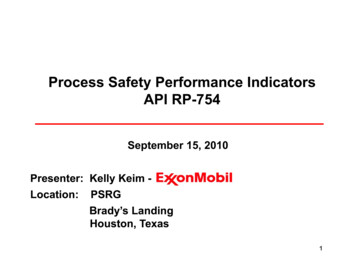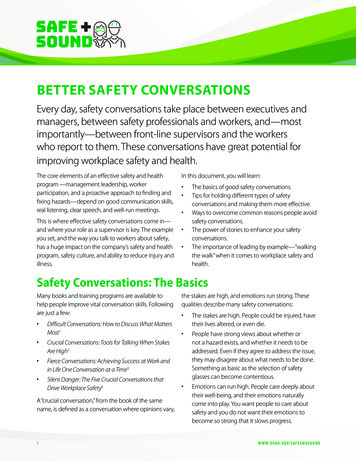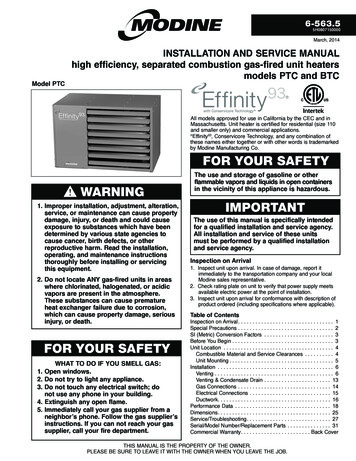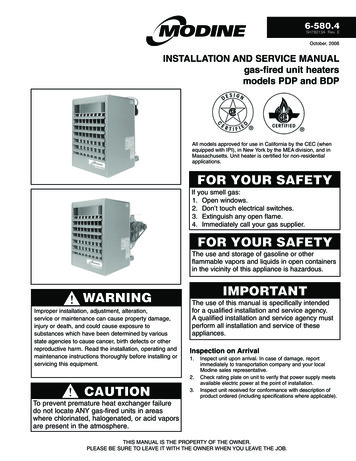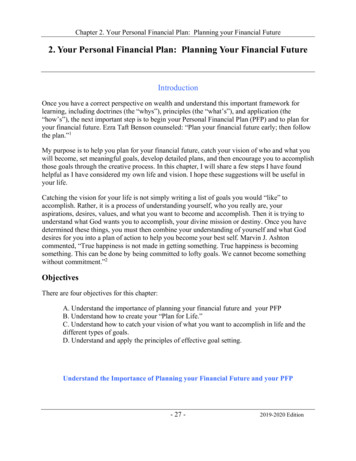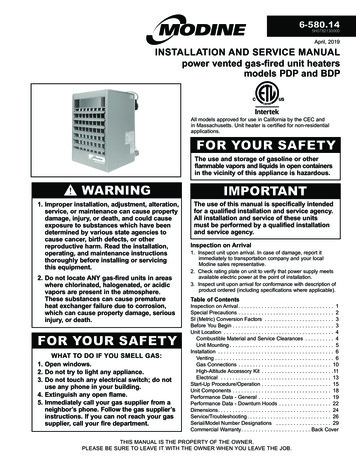
Transcription
6-580.145H0782130000April, 2019INSTALLATION AND SERVICE MANUALpower vented gas-fired unit heatersmodels PDP and BDPAll models approved for use in California by the CEC andin Massachusetts. Unit heater is certified for non-residentialapplications.FOR YOUR SAFETYThe use and storage of gasoline or otherflammable vapors and liquids in open containersin the vicinity of this appliance is hazardous.WARNING1. Improper installation, adjustment, alteration,service, or maintenance can cause propertydamage, injury, or death, and could causeexposure to substances which have beendetermined by various state agencies tocause cancer, birth defects, or otherreproductive harm. Read the installation,operating, and maintenance instructionsthoroughly before installing or servicingthis equipment.2. D o not locate ANY gas-fired units in areaswhere chlorinated, halogenated, or acidicvapors are present in the atmosphere.These substances can cause prematureheat exchanger failure due to corrosion,which can cause property damage, seriousinjury, or death.FOR YOUR SAFETYWHAT TO DO IF YOU SMELL GAS:1. Open windows.2. Do not try to light any appliance.3. D o not touch any electrical switch; do notuse any phone in your building.4. E xtinguish any open flame.5. I mmediately call your gas supplier from aneighbor’s phone. Follow the gas supplier’sinstructions. If you can not reach your gassupplier, call your fire department.IMPORTANTThe use of this manual is specifically intendedfor a qualified installation and service agency.All installation and service of these unitsmust be performed by a qualified installationand service agency.Inspection on Arrival1. Inspect unit upon arrival. In case of damage, report itimmediately to transportation company and your localModine sales representative.2. Check rating plate on unit to verify that power supply meetsavailable electric power at the point of installation.3. Inspect unit upon arrival for conformance with description ofproduct ordered (including specifications where applicable).Table of ContentsInspection on Arrival . . . . . . . . . . . . . . . . . . . . . . . . . . . . . . . . . 1Special Precautions . . . . . . . . . . . . . . . . . . . . . . . . . . . . . . . . . . 2SI (Metric) Conversion Factors . . . . . . . . . . . . . . . . . . . . . . . . . 3Before You Begin . . . . . . . . . . . . . . . . . . . . . . . . . . . . . . . . . . . 3Unit Location . . . . . . . . . . . . . . . . . . . . . . . . . . . . . . . . . . . . . . . 4Combustible Material and Service Clearances . . . . . . . . . . . 4Unit Mounting . . . . . . . . . . . . . . . . . . . . . . . . . . . . . . . . . . . . 5Installation . . . . . . . . . . . . . . . . . . . . . . . . . . . . . . . . . . . . . . . . . 6Venting . . . . . . . . . . . . . . . . . . . . . . . . . . . . . . . . . . . . . . . . . 6Gas Connections . . . . . . . . . . . . . . . . . . . . . . . . . . . . . . . . . 10High-Altitude Accessory Kit . . . . . . . . . . . . . . . . . . . . . . . . . 11Electrical . . . . . . . . . . . . . . . . . . . . . . . . . . . . . . . . . . . . . . . 13Start-Up Procedure/Operation . . . . . . . . . . . . . . . . . . . . . . . . . 15Unit Components . . . . . . . . . . . . . . . . . . . . . . . . . . . . . . . . . . . 18Performance Data - General . . . . . . . . . . . . . . . . . . . . . . . . . . 19Performance Data - Downturn Hoods . . . . . . . . . . . . . . . . . . . 22Dimensions . . . . . . . . . . . . . . . . . . . . . . . . . . . . . . . . . . . . . . . 24Service/Troubleshooting . . . . . . . . . . . . . . . . . . . . . . . . . . . . . 26Serial/Model Number Designations . . . . . . . . . . . . . . . . . . . 29Commercial Warranty . . . . . . . . . . . . . . . . . . . . . . . . Back CoverTHIS MANUAL IS THE PROPERTY OF THE OWNER.PLEASE BE SURE TO LEAVE IT WITH THE OWNER WHEN YOU LEAVE THE JOB.
SPECIAL PRECAUTIONSWARNINGSPECIAL PRECAUTIONSTHE INSTALLATION AND MAINTENANCE INSTRUCTIONS INTHIS MANUAL MUST BE FOLLOWED TO PROVIDE SAFE,EFFICIENT AND TROUBLE-FREE OPERATION. IN ADDITION,PARTICULAR CARE MUST BE EXERCISED REGARDING THESPECIAL PRECAUTIONS LISTED BELOW. FAILURE TOPROPERLY ADDRESS THESE CRITICAL AREAS COULDRESULT IN PROPERTY DAMAGE OR LOSS, PERSONALINJURY, OR DEATH. THESE INSTRUCTIONS ARE SUBJECTTO ANY MORE RESTRICTIVE LOCAL OR NATIONAL CODES.12. When servicing or repairing this equipment, use onlyfactory-approved service replacement parts. A completereplacements parts list may be obtained by contactingthe factory. Refer to the rating plate on the appliance forcomplete appliance model number, serial number, andcompany address. Any substitution of parts or controls notapproved by the factory will be at the owner's risk.CAUTIONHAZARD INTENSITY LEVELS1. DANGER: Indicates an imminently hazardous situationwhich, if not avoided, WILL result in death or serious injury.2. WARNING: Indicates a potentially hazardous situationwhich, if not avoided, COULD result in death or serious injury.3. CAUTION: Indicates a potentially hazardous situation which,if not avoided, MAY result in minor or moderate injury.4. IMPORTANT: Indicates a situation which, if not avoided,MAY result in a potential safety concern.DANGERAppliances must not be installed where they may be exposedto a potentially explosive or flammable atmosphere.WARNING1. Gas fired heating equipment must be vented - do notoperate unvented.2. A built-in power exhauster is provided - additional externalpower exhausters are not required or permitted.3. If an existing heater is being replaced, it may be necessaryto resize the venting systems. Improperly sized ventingsystems can result in vent gas leakage or the formation ofcondensate. Refer to the National Fuel Gas Code ANSIZ223.1 (NFPA 54) or CSA B149.1 – latest edition. Failureto follow these instructions can result in injury or death.4. Under no circumstances should two sections of doublewall vent pipe be joined together within one horizontalvent system due to the inability to verify complete seal ofinner pipes.5. All field gas piping must be pressure/leak tested prior tooperation. Never use an open flame. Use a soap solutionor equivalent for testing.6. Gas pressure to appliance controls must never exceed14" W.C. (1/2 psi).7. To reduce the opportunity for condensation, the minimumsea level input to the appliance, as indicated on the serialplate, must not be less than 5% below the rated input, or5% below the minimum rated input of dual rated units.8. Disconnect power supply before making wiringconnections to prevent electrical shock and equipmentdamage.9. All appliances must be wired strictly in accordance withwiring diagram furnished with the appliance. Any wiring different from the wiring diagram could result in a hazardto persons and property.10. Any original factory wiring that requires replacement mustbe replaced with wiring material having a temperaturerating of at least 105 C.11. Ensure that the supply voltage to the appliance, asindicated on the serial plate, is not 5% greater than therated voltage.21. All literature shipped with this unit should be kept forfuture use for servicing or service diagnostics. Do notdiscard any literature shipped with this unit.2. Consult piping, electrical, and venting instructions in thismanual before final installation.3. Do not attach ductwork, air filters, or polytubes to anypropeller unit heater.4. Clearances to combustible materials are critical. Be sureto follow all listed requirements.5. Heaters are designed for use in heating applications withambient startup temperatures between -40 F and 90 Fand ambient operating temperatures between 40 F and90 F.6. Do not install unit outdoors.7. In garages or other sections of aircraft hangars such asoffices and shops that communicate with areas used forservicing or storage, keep the bottom of the unit at least7' above the floor unless the unit is properly guarded toprovide user protection from moving parts. In parkinggarages, the unit must be installed in accordance with thestandard for parking structures ANSI/NFPA 88A - latestedition, and in repair garages the standard for repairgarages NFPA 30A - latest edition (formerly NFPA 88B).In Canada, installation of heaters in airplane hangarsmust be in accordance with the requirements of theenforcing authority, and in public garages in accordancewith the current CSA-B149 codes.8. In aircraft hangars, keep the bottom of the unit at least 10'from the highest surface of the wings or engine enclosureof the highest aircraft housed in the hangars and inaccordance with the requirements of the enforcingauthority and/or NFPA 409 - latest edition.9. Installation of units in high humidity or salt wateratmospheres will cause accelerated corrosion, resultingin a reduction of the normal life of the units.10. Do not install units below 7' measured from the bottom ofthe unit to the floor in commercial applications (unless unitis properly guarded to provide user protection frommoving parts).11. Be sure no obstructions block air intake and discharge ofunit heaters.12. The minimum distance from combustible material is basedon the combustible material surface not exceeding 160 F.Clearance from the top of the unit may be required to begreater then the minimum specified if heat damage, otherthan fire, may occur to materials above the unit heater atthe temperature described.13. Allow 18" of clearance at rear (or 12" beyond end ofmotor at rear of unit, whichever is greater) and accessside to provide ample air for proper operation of fan.14. Installation must conform with local building codes or inthe absence of local codes, with the National Fuel GasCode, ANSI Z223.1 (NFPA 54) - latest edition. In Canadainstallation must be in accordance with CSA-B149.1.6-580.14
SPECIAL PRECAUTIONS / SI (METRIC) CONVERSION FACTORSBEFORE YOU BEGINCAUTION15. Purging of air from gas supply line should be performedas described in the National Fuel Gas Code, ANSI Z223.1(NFPA 54) - latest edition. In Canada, installation must bein accordance with CSA-B149.1.16. When leak testing the gas supply piping system, theappliance and its combination gas control must beisolated during any pressure testing in excess of 14" W.C.(1/2 psi).17. The unit should be isolated from the gas supply pipingsystem by closing its field installed manual shut-off valve.This manual shut-off valve should be located within 6’ ofthe heater.18. Turn off all gas before installing appliance.19. Ensure that the supply voltage to the appliance, asindicated on the serial plate, is not less than 5% below therated voltage.20. Check the gas inlet pressure at the unit upstream of thecombination gas control. The inlet pressure should be6-7" W.C. on natural gas or 11-14" W.C. on propane. Ifinlet pressure is too high, install an additional pressureregulator upstream of the combination gas control.21. Service or repair of this equipment must be performed bya qualified service agency.22. Do not attempt to reuse any mechanical or electronicignition controller which has been wet. Replace defectivecontroller.IMPORTANT1. To prevent premature heat exchanger failure, do not locateANY gas-fired appliances in areas where corrosive vapors(i.e. chlorinated, halogenated, or acidic) are present in theatmosphere.2. To prevent premature heat exchanger failure, the input tothe appliance as indicated on the serial plate, must notexceed the rated input by more than 5%.3. Start-up and adjustment procedures must be performedby a qualified service agency.CAUTION1. All literature shipped with this unit should be kept for futureuse for servicing or service diagnostics. Leave manual withthe owner. Do not discard any literature shipped with this unit.2. C onsult piping, electrical, and venting instructions in thismanual before final installation.3. D o not attach ductwork, air filters, or polytubes to anypropeller unit heater.In the U.S., the installation of these units must comply with theNational Fuel Gas Code, ANSI Z223.1 (NFPA 54) - latest editionand other applicable local building codes. In Canada, theinstallation of these units must comply with local plumbing orwaste water codes and other applicable codes and with thecurrent code CSA-B149.1.1. All installation and service of these units must beperformed by a qualified installation and service agencyonly as defined in ANSI Z223.1 (NFPA 54) - latest editionor in Canada by a licensed gas fitter.2. This unit is certified with the controls furnished. Forreplacements parts, please order according to thereplacement parts list on serial plate. Always know yourmodel and serial numbers. Modine reserves the right tosubstitute other authorized controls as replacements.3. Unit is balanced for correct performance. Do not alter fanor operate motors at speeds below what is shown in thismanual.4. Information on controls is supplied separately.5. The same burner is used for natural and propane gas.SI (Metric) Conversion Factors6-580.14To Convert"W.C. FBTUBtu/ft3Btu/hrCFH (ft3/hr)CFH (ft3/hr)CFM (ft3/min)CFM poundpsigpsigMultiply By0.249( F-32) x 20.3050.003793.793.7974625.40.4546.8927.7To ObtainkPa W.C.3
SI (METRIC) CONVERSION FACTORS / UNIT LOCATIONUNIT LOCATIONDANGERAppliances must not be installed where they may be exposedto a potentially explosive or flammable atmosphere.CAUTION1. Clearances to combustible materials are critical. Be sureto follow all listed requirements.2. Heaters are designed for use in heating applications withambient startup temperatures between -40 F and 90 F andambient operating temperatures between 40 F and 90 F.3. Do not install unit outdoors.4. In garages or other sections of aircraft hangars suchas offices and shops that communicate with areas used forservicing or storage, keep the bottom of the unit at least7' above the floor unless the unit is properly guarded.In parking garages, the unit must be installed in accordancewith the standard for parking structures ANSI/NFPA 88A latest edition, and in repair garages the standard for repairgarages NFPA 30A - latest edition (formerly NFPA 88B).In Canada, installation of heaters in airplane hangars mustbe in accordance with the requirements of the enforcingauthority, and in public garages in accordance with thecurrent CSA-B149 codes.5. In aircraft hangars, keep the bottom of the unit at least10' from the highest surface of the wings or engine enclosure of the highest aircraft housed in the hangarsand in accordance with the requirements of the enforcingauthority and/or NFPA 409 – latest edition.6. Installation of units in high humidity or salt wateratmospheres will cause accelerated corrosion resulting ina reduction of the normal life of the units.IMPORTANTTo prevent premature heat exchanger failure, do not locateANY gas-fired appliances in areas where corrosive vapors (i.e.chlorinated, halogenated or acidic) are present in the atmosphere.Location Recommendations9. Do not install units in locations where gas ignition systemis exposed to water spray, rain, or dripping water.10. Do not install units below 7', measured from the bottomof the unit to the floor, unless properly guarded to provideprotection from moving parts.Figure 4.1 - Combustible Material and Service ClearancesCAccessSideBADTable 4.1 - Combustible Material Clearances jAccess Non-AccessModelSideSideTop "12"VentConnector(Not shown)6"7"jP rovide sufficient room around the heater to allow for propercombustion and operation of fan. Free area around the heater mustnot be less than 1-1/2 times the discharge area of the unit.Table 4.2 - Recommended Service ClearancesAccess Non-AccessModelSideSideTop 6"22"25"VentConnector(Not shown)6"7"Combustion Air RequirementsThe National Fuel Gas Code defines an “unconfined space” asa space whose volume is greater than 50 cubic feet per 1,000Btu/Hr input of the installed appliance(s). A confined space is50 cubic feet or less per 1,000 Btu/Hr input of the installedappliance(s).1. When locating the heater, consider general space andheating requirements, availability of gas and electricalsupply, and proximity to vent locations.2. Avoid installing units in extremely drafty locations. DraftsUnits installed in tightly sealed buildings or confined spacescan cause burner flames to impinge on heat exchangersmust be provided with two permanent openings, one near thewhich shortens life. Maintain separation between units sotop of the confined space and one near the bottom. Eachdischarge from one unit will not be directed into the inletopening should have a free area of not less than one squareof another.inch per 1,000 BTU per hour of the total input rating off all units3. Be sure the structural support at the unit location site isin the enclosure, freely communicating with interior areas adequate to support the unit's weight. For proper operationhaving, in turn adequate infiltration from the outside.the unit must be installed in a level horizontal position.For further details on supplying combustion air to a confined4. Do not install units in locations where the flue products can(tightly sealed) space or unconfined space, see the Nationalbe drawn into the adjacent building openings such asFuel Gas Code ANSI Z223.1 (NFPA 54) or CSA-B149.1windows, fresh air intakes, etc.Installation Code - latest edition.5. Be sure that the minimum clearances to combustiblematerials and recommended service clearances aremaintained. Units are designed for installation on non-Sound and Vibration Levelscombustible surfaces with the minimum clearances shownAll standard mechanical equipment generates some sound andin Figure 4.1 and Tables 4.1 and 4.2.vibration that may require attenuation. Libraries, private offices6. Units exposed to inlet air temperatures of 40 F or less,and hospital facilities will require more attenuation, and in suchmay experience condensation, therefore, provisions shouldcases, an acoustical consultant may be retained to assist in thebe made for disposal of condensate.application. Locating the equipment away from the critical area7. When locating units, it is important to consider that theis desirable within ducting limitations. Generally, a unit shouldexhaust vent piping must be connected to the outsidebe located within 15' of a primary support beam. Smalleratmosphere.deflections typically result in reduced vibration and noise8. Maximum equivalent vent lengths are listed in "Section A transmission.General Instruction - All Units" of the Venting Instructions.46-580.14
INSTALLATIONUNIT MOUNTING1. B e sure the means of suspension is adequate to support theweight of the unit (see pages 24 and 25 for unit weights).Figure 5.1 - Adjustable Mounting Brackets - To Adjust:2. F or proper operation and to assure that flames are directedinto the center of the heat exchanger tubes, the unit must beinstalled in a level horizontal position. Use a spirit level toensure that the unit is suspended correctly.1. Remove outer side panels.2. “Set screws” - loosen andposition bracket where needed– then tighten set screws.3. C learances to combustibles as specified in Figure 4.1 andTa bles 4.1 and 4.2 must be strictly maintained.3. Re-attach outer side panels.4. All standard units are shipped fully boxed. Larger units arealso supplied with skid supports on the bottom of the box.The larger units may be lifted from the bottom by means of afork lift or other lifting device only if the shipping support skidsare left in place and the forks support the whole depth of theunit. If the unit must be lifted from the bottom for finalinstallation without the carton in place, be sure to properlysupport the unit over its entire length and width to preventdamage. When lifting units, make sure the load is balanced.Figure 5.2 - Suspension Methods5. P ropeller models up to
3. If an existing heater is being replaced, it may be necessary to resize the venting systems. Improperly sized venting systems can result in vent gas leakage or the formation of condensate. Refer to the National Fuel Gas Code ANSI Z223.1 (NFPA 54) or CSA B149.1 – latest edition. Failure




